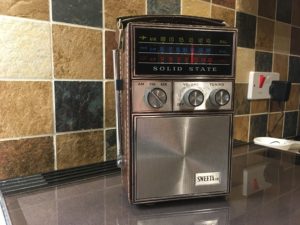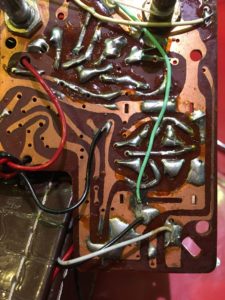Way back in the mists of time, the early 1970s to be precise, my interest in electronics and radio was just getting going. I’d had the Philips Radionics Kits to get things started…who didn’t need a bedroom alarm, that was triggered when one of your siblings sneaked into your bedroom…and just happened to shine a torch at your latest project. I discovered I could build radios with them and more importantly, a little Medium Wave transmitter. Its range was probably only a hundred yards, but it allowed me to listen to my music on a radio, anywhere in the garden; this was of course, magic 😉
I also used to listen to the local police and aircraft on one of my Dad’s radios, so one Christmas, Santa Claus brought me my own airband radio. It came in the form of a Sweeta AIR Solid State transistor radio from Makro in Washington. It received Medium Wave (AM) which was still popular with broadcasters back then, VHF (FM) where the high quality stations were, and of course AIR band, hence the name. On the air band I could hear aircraft and the local police; they hadn’t encrypted their transmissions at the time.
We used to go on holiday to a farm in South West Scotland, just outside Palnackie, called South Glen. Ackie and Helen Bell ran the farm along with bed and breakfast facilities which we used to use every year. Ackie and I spent many evenings watching the stars and the passing satellites…and we also listened to the local police and their escapades.
As I got older, my Sweeta AIR suffered the ravages of time and at some point left the family; I’m not sure if it was given or thrown away. The case on these radios is made of thin leatherette style plastic, on a cardboard shell. The build quality isn’t good.
I put a search on eBay for one about six years ago, and similar radios turned up but not the same. Two weeks before writing this page, one turned up that was exactly the same as the one I had…so I bought it.
It didn’t need much doing. The volume control was scratchy, but then they always are; it was fixed by using some safe contact cleaner and lubricant to save dismantling the control. Even then the sound coming from the speaker was almost inaudible. I contacted the seller who said it had been fine before it was sent. I suspected the earphone socket, but that was in order, so next I started lightly touching and moving components, suspecting a dry joint. When I touched one of the resistors in the audio stage, the radio volume went right up to normal.
The circuit board was carefully extracted, after carefully removing the knobs. I discovered a connection on the back of the printed circuit board that had never been soldered properly when the radio was new, almost fifty years ago. Once this was repaired and the tuning pointer straightened up, the radio worked exactly as it should.
The final thing was to fit a new battery carrier for the four ‘C’ cells the radio uses; I have the original but it has cracked over the years. You never know, it might ‘see me out’ as many people say. It turns out these radios are quite collectable now.


